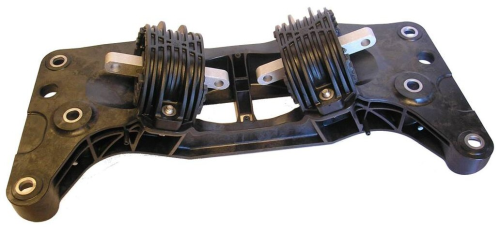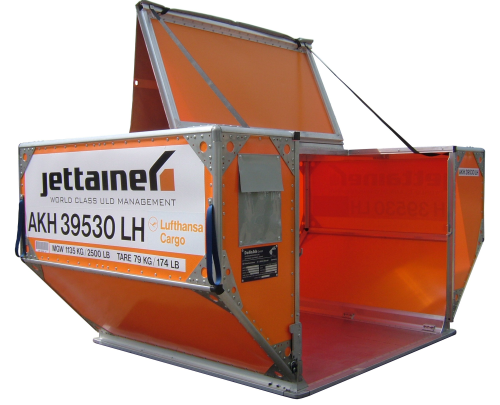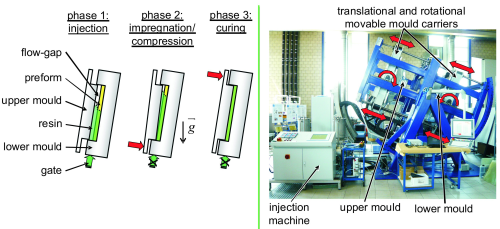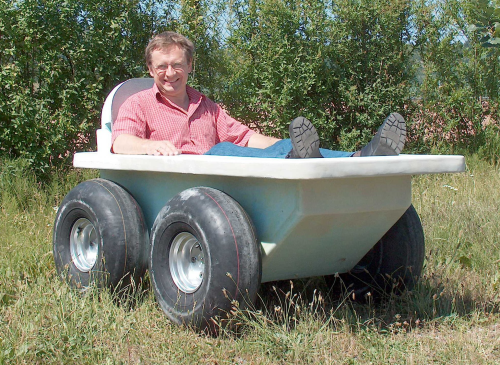



AVK presented five winners with Innovation Awards during the Composites Night on 26 October, part of the International AVK Conference taking place at the start of COMPOSITES EUROPE 2009.
The prizes were awarded in four categories.
Industrial category
In the Industrial category, Volkswagen (VW) AG and the Technical University of Dresden (TU Dresden), Germany, shared the first prize with the BMW Group.
Car maker VW and the Institut für Leichtbau und Kunststofftechnik (Institute for Lightweight Construction and Plastics Engineering) at TU Dresden presented their thermoplastic hybrid structures. These are structural components made of plastic and reinforced with local textile inserts (thermoplastic glass fibre prepregs) in areas exposed to high levels of stress. Using this construction, it is possible to substitute highly stressed, structural metal components with lower weight plastic parts.
An example of this technique is a Volkswagen seat pan made using a production method that combines the economic series production technique of compression moulding long fibre reinforced thermoplastics, with inserts reinforced with endless fibres. The seat pan consists of long glass fibre reinforced polypropylene (PP) and features PP inserts reinforced with endless glass fibres in areas likely to be affected by crashes and in places where force is applied. It meets the mechanical requirements of the technical specification and enables a 45% weight reduction compared to conventional seat pans made of steel.
BMW also won an award in the Industry category for its development of a plastic transmission cross beam.
Until now transmission cross beams for BMW cars have been made of diecast aluminium. The part is required to fulfill performance characteristics such as operating strength, heat management, acoustics, and crash behaviour. To reduce the part's weight BMW wanted to see if it was possible to make the component from glass fibre reinforced plastic.
A selection of composite materials were evaluated, and for further development the injection moulding technology using polyamide (PA) 66 and 50% glass fibre was selected.
The first application for the plastic transmission cross beam is the new BMW 5Series GT. The space required and mounting concept are identical to that for the aluminum part previously used. The weight reduction achieved is approximately 1 kg.
Environmental category
DSM Dyneema BV and DSM Composite Resins AG, in collaboration with DoKaSch ACE GmbH, won the award in this category for an air cargo container made using composite panels.
Following two years of trials, DoKaSch GmbH, a manufacturer of air cargo equipment, introduced the AKE Iw-65 air cargo container, which is made using RP10 composite panels employing DSM's Dyneema® fibre and Aeronite® resin. The AKE container is around 20% (15.5 kg) lighter than standard aluminium containers, leading to reduced fuel use and emissions. The RP10 panels are also up to four times stronger than aluminium sheet and have excellent resistance to impacts and wear and tear which helps to lower maintenance costs.
Based on the success of the AKE (lower deck) container, DoKaSch has added the AKH (main deck) container to its lightweight container range, which also uses RP10 panels.
The containers can be manufactured in any airline colour, enabling easy identification.
University category
The Institut für Kunststoffverarbeitung (Institute of Plastics Processing) at the RWTH Aachen (IKV) won this category for studies into the automatic and large-series production of continuous fibre reinforced plastics parts by the gap impregnation technique (a variant of resin transfer moulding).
The gap impregnation process is a means of speeding up the impregnation of the preform. Unlike an RTM mould, the geometry of the mould cavity can be changed during the process and a flow gap for fast distribution of the resin can be created on top of the preform. To achieve high fibre content the preform can be compressed by a movement of the mould sections.
A prototype gap impregnation process was developed at IKV in cooperation with Hille Engineering. It has been demonstrated that parts of dimensions 500 x 500 mm2 with fibre volume contents of 50% can be manufactured in cycle times of under 10 minutes. Impregnation and compression only take 19 seconds, a significant reduction compared to the RTM process.
IKV believes this process would be of benefit to the automotive, transportation and aerospace sectors.
Special award
cpm composite products mücke was awarded a special prize for its Splash Car, a recreational, all-terrain electric vehicle. The main component of the vehicle is a lightweight tub made of a fibre reinforced epoxy resin with a foam core.
The car is powered by 4 kW electric motors. Lithium-polymer battery technology allows up to one hour of operation at full power and speed (40 km/h). The car is steered by a joystick control.
The vehicle is very economic to operate – one hour of operation costs only about 80 Eurocents. Unlike vehicles such as motorbikes, karts and quad bikes, the SplashCar does not produce any noise or exhaust emissions.
Potential uses for the car could include a fun vehicle for leisure parks, hotels and individual users, and for observing wildlife.
